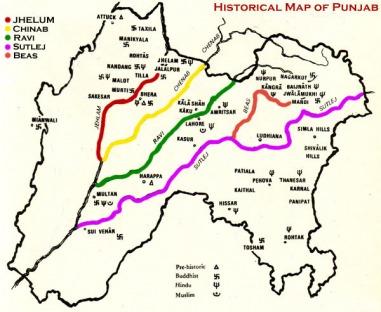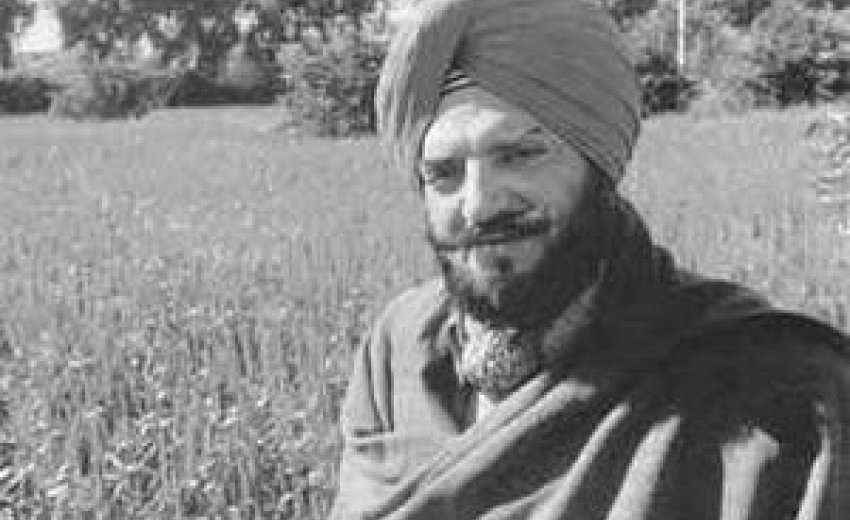 Recently I wrote an article on the months and seasons (Bara Maha) of Panjab. The article was edited and the spelling of Panjab was changed to Punjab. The correct spelling is Panjab and not Punjab. India and University have changed the names of their cities as the British had their own spellings, The word derived from Persian ("Land of the Five Rivers"), from panj, "five") and (ab, "water"), referring to five rivers of the Panjab region; the Jhelum, the Chenab, the Ravi, the Sutlej and the Beas. The spelling check on computers does not help, as it is Punjab and without any thought, the true meaning is changed and the essence lost.
Recently I wrote an article on the months and seasons (Bara Maha) of Panjab. The article was edited and the spelling of Panjab was changed to Punjab. The correct spelling is Panjab and not Punjab. India and University have changed the names of their cities as the British had their own spellings, The word derived from Persian ("Land of the Five Rivers"), from panj, "five") and (ab, "water"), referring to five rivers of the Panjab region; the Jhelum, the Chenab, the Ravi, the Sutlej and the Beas. The spelling check on computers does not help, as it is Punjab and without any thought, the true meaning is changed and the essence lost.
Panjab, the famous 'Land of Five Rivers' is a semi-arid landlocked region in the north-western part of South Asia (the Indian sub-continent). Its name is derived from the Persian words 'panj' meaning 'five' and 'ab' meaning 'water'. The spelling of 'Panjab' is used here to represent the whole area.
Panjab (Persian, "five, water"; land of five rivers) is the homeland of the Sikhs. The present North West Indian state of Panjab was created in 1966, excluding former areas that now compose Himachal Pradesh and Haryana. The state language is Panjabi, and the Sikhs outnumber the Hindus. Previously, in 1947, the much larger British Panjab was partitioned between Pakistan and India, with the boundary dividing Amritsar. Thousands of Sikhs moved from East to West but remained anxious for free access to the holy places in a relatively, if not completely, autonomous homeland. Panjab's geographical position, as a gateway for successive invasions of India to the far West, and its extremes of climate and relative fertility, have moulded an enterprising high spirited people. (A.G.H). Many suffered torture, communal strife, violence, extortion, persecution, indiscriminate killings, rape, families were divided during this period of unprecedented exodus, nearly 20,000 Sikhs lost their lives Mr. John McDonnell, the MP for Hayes and Harlington in his article: The Panjabi community states that the second-largest ethnic minority in my constituency are members of the Asian community who derive their origin from the Panjab. This is the first time that a British Parliament has specifically addressed the Panjabi community in Britain. Not only he represents a constituency with more than 15,000 community members whose origins lie in the Panjab, but also founding chair of the all-party group on the Panjabi community.
"Language can be important, especially when dealing with Britain's colonial past, and Mr McDonnell clarified an issue of pronunciation of the word Panjab. Many of his Panjabi friends and colleagues advise him that the terms "Punjab" and "Punjabi" are colonial mispronunciations of the more exact pronunciations "Panjab" and "Panjabi". He has apologised for this mispronunciation and spelling and it is documented in the Hansard, that the correct spelling and pronunciation should be "Panjab" and not Punjab which misleads and does not reflect the Land of Five Rivers.
Panjab literally means the Land of the Five Rivers. It has a history that flows from the ancient civilisation of the Indus valley in approximately 2000 BC, through a series of empires and Mughal dynasties, to the founding of Sikh faith in the 15th century by Guru Nanak Dev Ji. It is important to note that the Sikh faith is neither sectarian nor communal. Although it gave the Panjab a unique culture, its gift was secular tolerance in government and public life. The Panjab came under British rule in the 19th century and, on independence in 1947, sadly the region was split between India and Pakistan, leaving a much smaller state of Panjab to the Sikhs and the rest is in Pakistan; this still remains a bone of contention!
It is amazing that people find it difficult to change their own coinage of words. The article in the Hansard about the Panjabi community still spells the world Panjabi as Punjabi and so far no amendments have been made. I just wonder how much lip-service is paid to this very important word Panjab. It rightly deserves the correct spelling and it should be uniformed through word search that the correct spelling springs up as PANJAB and not Punjab. It is an injustice to spell the original Panjab to suit priorities of others.
Panjab, in fact, represents the vast fertile plain through which the five rivers flow after they leave the Himalayan Mountain ranges. The five rivers of Panjab, all tributaries of the mighty Indus River, are the Jhelum, Chenab, Ravi, Beas and Sutlej (from west to east). These five rivers have their originating source in the Himalayan Mountains as small lakes and rely on melting snow and monsoon rains. They flow in a northeast to a southwest direction across the immense alluvial plains of Panjab. The confluence of the five rivers of Panjab is named Panjnad (the five streams). The river waters then enter the Indus River, which finally ends in the Arabian Sea. Both the Indus and Sutlej are antecedent rivers with stupendous crossings of the Himalayan ranges through spectacular gorges.
Other than the Himalayan Mountains, Dhauladhar range and Salt Range (Lunn Pahar), Panjab also has the Sulaiman range in the west, spurs of the Aravalli range in the south-east and the Shivalik hills in the north-east. Others hill ranges are the Kala Chitta, Murree, Margalla, Pabbi, and Solar Singhi and the low hills of Chiniot, Kirana and Sangla. There is also the Pothohar Plateau between the Indus and Jhelum rivers and the Thal desert and Cholistan desert (locally known as Rohi) and parts of the Thar Desert. The Panjab plain itself lies between 180 and 300 meters above sea level. In actual fact, the plains of Panjab are a fairly recent creation of Kudrat (Creative Power of God) in geological terms - about 11 million years ago.
Panjab lies between the longitudes of 70 degrees E to 78 degrees E and the latitudes of 29 degrees N to 34 degrees N. The geographical boundaries of Panjab are quite distinct from the rest of the Indian sub-continent. Panjab is bounded on the north by the vast Himalayan mountain ranges; on the east by the river Yamuna (a tributary of the Ganges); on the south by the deserts of Rajasthan and Sindh; and on the west by the Sulaiman range. Although the geographical boundaries of Panjab have been created by Kudrat, the political boundaries keep changing with the march of events.
Panj or Five, which originated from 5, is a significant number and refers to many important aspects of Sikh way of life. I am sure we all have heard of Panj Piyares (the Five Beloved Ones initiated in the Khalsa fold, Panj Takhat, the Five Sacred Thrones (Harimandir Sahib in Amritsar and Patna, Keshgarh Sahib, Damdama Sahib, and Sri Hazoor Sahib Abchalnagar), Panj Dhooths (Five Vices of kam, krodh, mobh, lobh and ahankar), Panj Granthis (Five priests), Panj Baniyes (Five Banis recited by a Gurusikh at Amritvela) and the Panj list is endless. Some even named educational institutions, musical groups and shops after Panjab to rekindle their links with their Homeland. Just a few examples to illustrate this are Gabru Panjad Dha, Panjab University, Panjab Sweet Centre etc. etc.
Jagjit Singh, a software expert was disappointed and rather perturbed that the word Panjab was mis-spelt but the spelling of other states was spelt correctly and there were high profile issues related to these states. What does this imply that Panjab is a low profile state? The correct spelling of Panjab did not find a place in the computer soft ware industry. He attempted to change the word of Punjab to Panjab but the computer was quick to mark it wrong and advised to go for a spell check. The question remains still unanswered and he found it disturbing that the spelling was rigidly to adhere to Punjab and was not receptive to any change. Wikipedia, Sikhipedia and Hutchinson Encylcopeadia all spell it Punjab and not Panjab. These records have to be amended sooner rather than later.
It is gratifying to note that the Google browser on Panjab shows that 98% of the 71 websites on Panjab spell it as Panjab. Writers have to mindful that correct spelling is used in their articles on Panjab and change their mindset, that any other spellings to suit others should be dismissed. Panjab is Panjab and let's ensure that the spelling remains the same to give proper credence and recognition.
Panjab is blessed by saints, pirs, bhagats and it is revered for its sacred shrines and temples. Some sacred sites have the power to heal the body, enlighten the mind, increase creativity/ knowledge or Gyan and the most importantly to awaken the soul to know it true purpose of our existence. The true purpose is to utter His Name or Naam and seek for sublime peace and salvation(jiwan mukta) The landscapes, the tress, rivers and the Gurdwaras are all sanctified and sacred to Panjab that gives its unique glamour and charm; the green wheat fields with golden yellow flowers of the mustard(sarson) is a natural magic.
Panjab is Panjab and all Sikhs or non-Sikhs who are proud of Panjab should strive to improve the environment for us to enjoy the freshness of the environment and be blessed in this sacred land.
References:
1. Deep (Defenders of the Environment and Ecology of the Panjab) by Sardar Pardeep Singh Rai 2006.
2. The Oxford Dictionary of World Religion by John Bowker; New York, Oxford University Press 1997; p 729.
3. McDonnell J; 2000. Panjabi Community. MP Hayes and Harlington, House of Commons Hansard Debates for 7 March 2000(pt 2).

